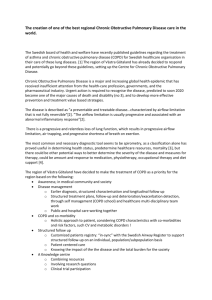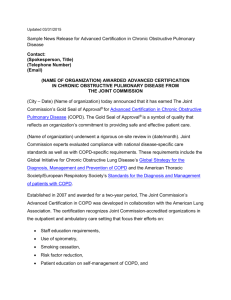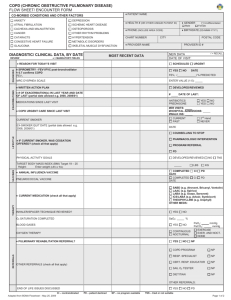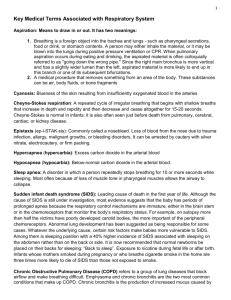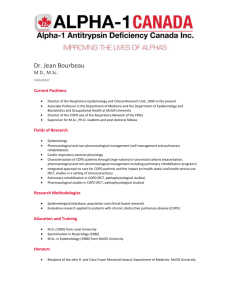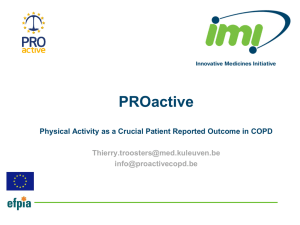Characterization of Glutamate receptors at the Drosophila
advertisement
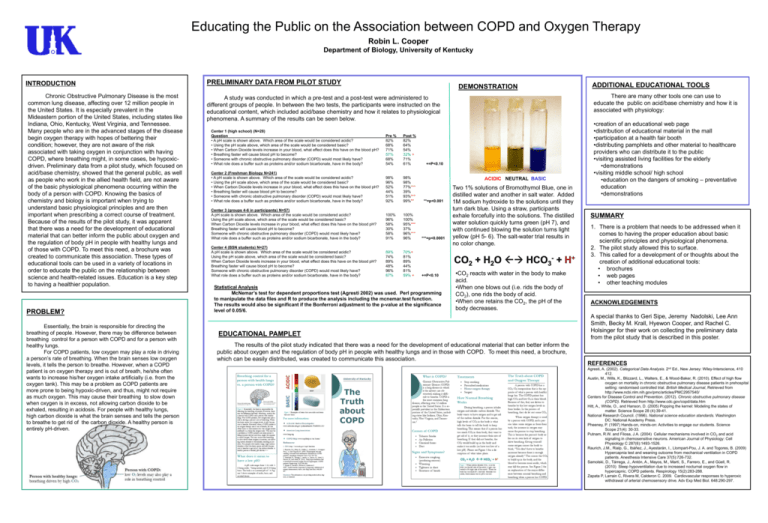
Educating the Public on the Association between COPD and Oxygen Therapy Robin L. Cooper Department of Biology, University of Kentucky INTRODUCTION Chronic Obstructive Pulmonary Disease is the most common lung disease, affecting over 12 million people in the United States. It is especially prevalent in the Mideastern portion of the United States, including states like Indiana, Ohio, Kentucky, West Virginia, and Tennessee. Many people who are in the advanced stages of the disease begin oxygen therapy with hopes of bettering their condition; however, they are not aware of the risk associated with taking oxygen in conjunction with having COPD, where breathing might, in some cases, be hypoxicdriven. Preliminary data from a pilot study, which focused on acid/base chemistry, showed that the general public, as well as people who work in the allied health field, are not aware of the basic physiological phenomena occurring within the body of a person with COPD. Knowing the basics of chemistry and biology is important when trying to understand basic physiological principles and are then important when prescribing a correct course of treatment. Because of the results of the pilot study, it was apparent that there was a need for the development of educational material that can better inform the public about oxygen and the regulation of body pH in people with healthy lungs and of those with COPD. To meet this need, a brochure was created to communicate this association. These types of educational tools can be used in a variety of locations in order to educate the public on the relationship between science and health-related issues. Education is a key step to having a healthier population. PROBLEM? Essentially, the brain is responsible for directing the breathing of people. However, there may be difference between breathing control for a person with COPD and for a person with healthy lungs. For COPD patients, low oxygen may play a role in driving a person’s rate of breathing. When the brain senses low oxygen levels, it tells the person to breathe. However, when a COPD patient is on oxygen therapy and is out of breath, he/she often wants to increase his/her oxygen intake artificially (i.e. from the oxygen tank). This may be a problem as COPD patients are more prone to being hypoxic-driven, and thus, might not require as much oxygen. This may cause their breathing to slow down when oxygen is in excess, not allowing carbon dioxide to be exhaled, resulting in acidosis. For people with healthy lungs, high carbon dioxide is what the brain senses and tells the person to breathe to get rid of the carbon dioxide. A healthy person is entirely pH-driven. PRELIMINARY DATA FROM PILOT STUDY DEMONSTRATION There are many other tools one can use to educate the public on acid/base chemistry and how it is associated with physiology: A study was conducted in which a pre-test and a post-test were administered to different groups of people. In between the two tests, the participants were instructed on the educational content, which included acid/base chemistry and how it relates to physiological phenomena. A summary of the results can be seen below. Center 1 (high school) (N=28) Question • A pH scale is shown above. Which area of the scale would be considered acidic? • Using the pH scale above, which area of the scale would be considered basic? • When Carbon Dioxide levels increase in your blood, what effect does this have on the blood pH? • Breathing faster will cause blood pH to become? • Someone with chronic obstructive pulmonary disorder (COPD) would most likely have? • What role does a buffer such as proteins and/or sodium bicarbonate, have in the body? Pre % 82% 68% 71% 57% 68% 54% Post % 82% 64% 54% 32% + 71% 61% Center 2 (Freshman Biology N=241) • A pH scale is shown above. Which area of the scale would be considered acidic? • Using the pH scale above, which area of the scale would be considered basic? • When Carbon Dioxide levels increase in your blood, what effect does this have on the blood pH? • Breathing faster will cause blood pH to become? • Someone with chronic obstructive pulmonary disorder (COPD) would most likely have? • What role does a buffer such as proteins and/or sodium bicarbonate, have in the body? 98% 96% 52% 44% 51% 92% 98% 98% 77%*** 39% 93%*** 99%** Center 3 (groups 4-6 in participants) N=57) A pH scale is shown above. Which area of the scale would be considered acidic? Using the pH scale above, which area of the scale would be considered basic? When Carbon Dioxide levels increase in your blood, what effect does this have on the blood pH? Breathing faster will cause blood pH to become? Someone with chronic obstructive pulmonary disorder (COPD) would most likely have? What role does a buffer such as proteins and/or sodium bicarbonate, have in the body? 100% 96% 58% 30% 58% 91% 100% 100% 95%*** 37% 96%*** 96% ***=p<0.0001 Center 4 (BSN students) N=27) A pH scale is shown above. Which area of the scale would be considered acidic? Using the pH scale above, which area of the scale would be considered basic? When Carbon Dioxide levels increase in your blood, what effect does this have on the blood pH? Breathing faster will cause blood pH to become? Someone with chronic obstructive pulmonary disorder (COPD) would most likely have? What role does a buffer such as proteins and/or sodium bicarbonate, have in the body? 89% 74% 89% 48% 96% 67% 70%+ 81% 89% 44% 81% 59% + +=P<0.10 +=P<0.10 ACIDIC NEUTRAL BASIC **=p<0.001 Statistical Analysis McNemar’s test for dependent proportions test (Agresti 2002) was used. Perl programming to manipulate the data files and R to produce the analysis including the mcnemar.test function. The results would also be significant if the Bonferroni adjustment to the p-value at the significance level of 0.05/6. ADDITIONAL EDUCATIONAL TOOLS Two 1% solutions of Bromothymol Blue, one in distilled water and another in salt water. Added 1M sodium hydroxide to the solutions until they turn dark blue. Using a straw, participants exhale forcefully into the solutions. The distilled water solution quickly turns green (pH 7), and with continued blowing the solution turns light yellow (pH 5- 6). The salt-water trial results in no color change. •CO2 reacts with water in the body to make acid. •When one blows out (i.e. rids the body of CO2), one rids the body of acid. •When one retains the CO2, the pH of the body decreases. EDUCATIONAL PAMPLET The results of the pilot study indicated that there was a need for the development of educational material that can better inform the public about oxygen and the regulation of body pH in people with healthy lungs and in those with COPD. To meet this need, a brochure, which can be easily distributed, was created to communicate this association. •creation of an educational web page •distribution of educational material in the mall •participation at a health fair booth •distributing pamphlets and other material to healthcare providers who can distribute it to the public •visiting assisted living facilities for the elderly •demonstrations •visiting middle school/ high school •education on the dangers of smoking – preventative education •demonstrations SUMMARY 1. There is a problem that needs to be addressed when it comes to having the proper education about basic scientific principles and physiological phenomena. 2. The pilot study allowed this to surface. 3. This called for a development of or thoughts about the creation of additional educational tools: • brochures • web pages • other teaching modules ACKNOWLEDGEMENTS A special thanks to Geri Sipe, Jeremy Nadolski, Lee Ann Smith, Becky M. Krall, Hyewon Cooper, and Rachel C. Holsinger for their work on collecting the preliminary data from the pilot study that is described in this poster. REFERENCES Agresti, A. (2002). Categorical Data Analysis. 2nd Ed., New Jersey: Wiley-Interscience, 410 412. Austin, M., Wills, K., Blizzard, L., Walters, E., & Wood-Baker, R. (2010). Effect of high flow oxygen on mortality in chronic obstructive pulmonary disease patients in prehospital setting: randomised controlled trial. British Medical Journal, Retrieved from http://www.ncbi.nlm.nih.gov/pmc/articles/PMC2957540/ Centers for Disease Control and Prevention. (2012). Chronic obstructive pulmonary disease (COPD). Retrieved from http://www.cdc.gov/copd/data.htm Hitt, A., White, O., and Hanson, D. (2005) Popping the kernel: Modeling the states of matter. Science Scope 28 (4):39-41. National Research Council. (1996). National science education standards. Washington DC: National Academy Press. Pheeney, P. (1997) Hands-on, minds-on: Activities to engage our students. Science Scope 21(4): 30-33. Putnam, R.W. and Filosa, J.A. (2004) Cellular mechanisms involved in CO2 and acid signaling in chemosensitive neurons. American Journal of Physiology: Cell Physiology C 287(6):1493-1526. Raurich, J.M., Rialp, G., Ibáñez, J., Ayestarán, I., Llompart-Pou, J. A. and Togores, B. (2009) Hypercapnia test and weaning outcome from mechanical ventilation in COPD patients. Anesthesia Intensive Care 37(5):726-732. Samolski, D., Tárrega, J., Antón, A., Mayos, M., Martí, S., Farrero, E., and Güell, R. (2010) Sleep hypoventilation due to increased nocturnal oxygen flow in hypercapnic. COPD patients. Respirology 15(2):283-288. Zapata P, Larrain C, Rivera M, Calderon C. 2009. Cardiovascular responses to hyperoxic withdrawal of arterial chemosensory drive. Adv Exp Med Biol. 648:290-297.


